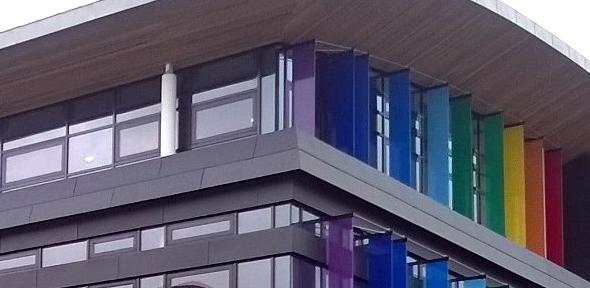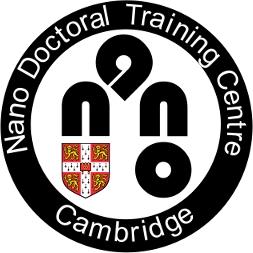
NanoDTC
This EPSRC and industry funded Centre for Doctoral Training delivers interdisciplinary 4-year PhD programme focussed on research in Nano.
Read more on: www.nanodtc.cam.ac.uk
Research themes
Energy Materials
Energy Materials Research at the NanoDTC involves innovation within photovoltaics, solar fuels, batteries and supercapacitors, all of which involve transport and reactions at or across interfaces. The focus is on finding ways to produce nanomaterials for each area that can be made with controlled architectures but also cheaply and with scalable production. For instance polymer solar cells require charge separation at material interfaces which are interpenetrating on the 10nm scale, but possess charge transport back to the electrodes hundreds of nanometres away. New Li+ battery materials have to facilitate ion transport through the atomic lattices but withstand the resulting cyclic expansions and contractions through charging cycles. Photocatalytic water splitting requires specific materials with high surface area that allow transport of electrolytes and gases. In all these areas, synergies between nanomaterial approaches are important and often unpredictable, for instance, the use of carbon nanotube or graphene electrodes for batteries, or the development of block-copolymer architectures for organic conducting polymer blends in light harvesting.
Research Groups involved include Optoelectronics (Physics), Grey Group (Chemistry), Reisner Lab (Chemistry), Hoffman Group (Engineering), Electron Microscopy (Materials) and several others.
Nano-Bio Technologies
Nano-Bio Technologies have seen one of the earliest translations of nanoscience into biomedical technologies, with uses in cellular imaging and mechanisms, sensing, regeneration, and targeting of disease. The NanoDTC research in Nano-Bio includes projects in ultra-high resolution imaging of biological (sub-cellular) entities, microfluidic assays and coded nanotag sensing, tip-neuron interactions and nano-mechanical cues for neuron re-growth, scaffolds for bone regeneration, ultrahigh sensitivity biomolecular sensing and neurotransmitter assays through plasmonics, ultra-high-speed genetic sequencing using nano-apertures, nanoparticle toxicity, and insect adhesion mechanisms at the nanoscale.
Research Groups involved include: Biological and Soft Systems (Physics), Knowles Lab (Chemistry), Scherman Group (Chemistry), Nanophotonics Group (Physics), Laser Analytics (Chemical Engineering and Biotechnology), Franze Lab (Physiology, Development and NeuroScience), Insect Biomechanics Group (Zoology) and many others.
Sustainable Nano
Research in Sustainable Nano focuses on tools and techniques that enable the translation of nano functionalities to industry in a scalable and sutainable manner. Sustainable nano refers to 'sustainable' in the broadest sense of the word, including efficient manufacturing processes such as self assembly, development of functional materials which minimise waste and use of natural materials and processes which are better for the environment. Creation of nanostructures with particular combinations of organic and inorganic components in specific registry, remains challenging, with only a handful of techniques available that can make these structures without the use of expensive lithographic techniques. An underpinning theme of our research in Sustainable Nano is thus developing new ways to produce such materials, and aiming for large-volume scalable routes to assembly and fabrication. Research in this area brings together teams involved in different aspects of producing nanomaterials, from using recognition molecules to self-assemble frameworks, to gas-phase growth of carbon nanotubes that condense into conducting rope. Theory plays an increasing role as hopes for some predictive power over nano-assembly grow. Bio-mimetic strategies are also an important activity, because they promise more sustainable use of materials through their entire life-cycle. Using cellulose nanofibrils broken down from trees to assemble photonic devices, using DNA oligomers to prescriptively dial up complex topologies, or using bacteria to express genes producing proteins assembling nanostructures, are all new directions pursued.
The research groups involved include: Nanomanufacturing Group (Engineering), Fluids in Advanced Manufacturing (Engineering), Scherman Group (Chemistry), Biological and Soft Systems (Physics), Vignolini Lab (Chemistry) , Nanophotonics Group (Physics), Frenkel Research Group (Chemistry) and several others.
Nano Electronics
NanoElectronics research is focussed on the continued evolution of massively parallel electronic architectures, which continue to be scaled down aggressively. A host of new materials and functionalities have joined this paradigm with ferroelectrics, spintronics, piezoelectrics, organic electronics, and non-Si semiconductors all reaping gains from nano-structured possibilities. While conventional fabrication is one route that it remains important to develop, many different tacks are now emerging: new semiconductor growth modes, exploitation of interface electronic states, printable devices, single quantum dot emitters, graphene nano-composites, magnetic nanowires, nanowire energy scavenging being just a few of research interest across Cambridge.
The research groups involved include: Electronic Devices and Materials (Engineering), Thin Film Magentism (Physics), Device Materials Group (Materials), Centre for Gallium Nitride (Materials), Microelectronics (Physics), Optoelectronics (Physics), Electron Microscopy (Materials), Graphene Research Centre (Engineering) and several others.
Nanophotonics
Nanophotonics is a research area of which the true potential has only just become evident, with confinement of light to the nanometre scale now demonstrated, but critically dependent on constructing systems with sub-nm control of spacings. This control is also critical in the area of quantum technologies, in which a number of our groups are pioneers, involving atoms, microcavities or quantum dots. Bio-inspired photonics is another strong area that is being developed at present.
The research groups involved include: Nanophotonics Group (Physics), Vignolini Lab (Chemistry), Centre for Gallium Nitride (Materials), Semiconductor Physics (Physics), Electronic Devices and Materials (Engineering), Graphene Research Centre (Engineering), Atomic, Mesoscopic and Optical Physics (Physics) and several others.
